|
|
|
Sort Order |
|
|
|
Items / Page
|
|
|
|
|
|
|
| Srl | Item |
| 1 |
ID:
174839
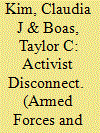

|
|
|
|
|
| Summary/Abstract |
Do activists seeking to challenge the U.S. military presence overseas succeed in persuading the local population? While the comparative literature on base contestation often makes implicit causal claims about public opinion and behavior, these claims have never been tested empirically using individual-level data. Based on an online survey, experiment with residents of communities hosting U.S. military bases in Korea and Japan, we demonstrate a disconnect between anti-base movements and local residents. Local public opinion is most responsive to pragmatic framing of opposition by social movements and tangible information about the consequences of base expansion. Other common activist tactics have little effect and may even backfire. Our findings fill an important gap in the growing literature on the politics of U.S. military bases abroad.
|
|
|
|
|
|
|
|
|
|
|
|
|
|
|
|
| 2 |
ID:
143285


|
|
|
|
|
| Summary/Abstract |
In response to China’s military modernization and growing anti-access/area denial capabilities, the US military has adopted an “Air Sea Battle” (ASB) concept entailing extensive strikes on the Chinese mainland. ASB has been embraced at the Pentagon and increasingly affects procurement decisions. Critics argue that ASB creates grave escalation risks and may incite an expensive arms race. Less discussed, but also of serious concern, is that ASB was adopted with little to no civilian oversight, in a case of “structural inattention.” This failure of civil–military relations derives from institutional factors such as the nature and composition of the White House staff, as well as from the administration’s pragmatic rather than strategic approach to China. It has also been facilitated by “subterranean factors” including the interests of influential military contractors and the military’s own inclination toward conventional warfare.
|
|
|
|
|
|
|
|
|
|
|
|
|
|
|
|
| 3 |
ID:
146909
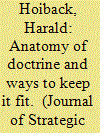

|
|
|
|
|
| Summary/Abstract |
The word ‘doctrine’ has been part of military terminology for more than 100 years. Even though the word is ubiquitous in modern military literature, it is still ambiguous and tends to put very different ideas into readers’ mind. In order to make the concept less vague and thus more useful, this paper explores the historical and pragmatic origin of the concept, and points out some of its potential pitfalls. The main message of the article is that, although it can be extremely hard to make a viable doctrine, it is worth the effort.
|
|
|
|
|
|
|
|
|
|
|
|
|
|
|
|
| 4 |
ID:
167823
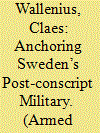

|
|
|
|
|
| Summary/Abstract |
The universal nature of conscription ties or anchors broad segments of society to the military. What happens to societal anchoring after the draft ends? Using in-depth interviews with two groups of elites, this article explores factors that promote and hinder the Swedish Military’s societal anchoring post-conscription. The first group consisted of 18 executives at the Swedish Armed Forces (SAF) headquarters with strategic positions in relation to societal anchoring. The second group consisted of 15 representatives from the corresponding political level: members of the parliamentary Committee on Defense and their officials. The interviews were semistructured and analyzed according to a grounded theory-inspired approach. Main themes concerning obstacles were the public’s low interest and dated knowledge, an unclear political debate resulting in vague expectations concerning the SAF, as well as unclear responsibility for informing the public, and confidence gaps between the military and the political elite.
|
|
|
|
|
|
|
|
|
|
|
|
|
|
|
|
| 5 |
ID:
134291


|
|
|
|
|
| Summary/Abstract |
Based on extensive field research in the Democratic Republic of the Congo (DR Congo), this article elucidates the logics, processes and readings surrounding certain ‘extra-military’ practices enacted by the Congolese army, namely the processing of various types of disputes between civilians. Exceeding the boundaries of the domain of ‘public security’, such activities are commonly categorised as ‘corruption’. Yet such labelling, founded on a supposed clear-cut public–private divide, obscures the underlying processes and logics, in particular the fact that these practices are located on a blurred public–private spectrum and result from both civilian demand and military imposition. Furthermore, popular readings of military involvement in civilian disputes are highly ambiguous, simultaneously representing it as ‘abnormal’ and ‘harmful’, and normalising it as ‘making sense’ – reflecting the militarised institutional environment and the weakness of civilian authorities in the eastern DR Congo. Strengthening these authorities will be vital for reducing this practice, which has an enkindling effect on the dynamics of conflict and violence.
|
|
|
|
|
|
|
|
|
|
|
|
|
|
|
|
| 6 |
ID:
189922
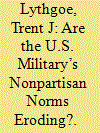

|
|
|
|
|
| Summary/Abstract |
The U.S. military’s nonpartisan norms are an important part of healthy civil–military relations. Some research, however, suggest these norms are weakening. This study examines the evidence for eroding nonpartisan norms by analyzing U.S. military servicemembers’ partisan affiliations and political activism levels from 2008 to 2018. It finds that since 2008, military servicemembers have become more likely to identify as partisans. Servicemembers have also become more politically active than civilians, although this is due to decreasing activism among the American public. It also finds that longer-serving service members have stronger nonpartisan norms, but that newer servicemembers are more politically active than both longer-serving servicemembers and civilians. These findings provide a firmer empirical foundation for previous claims of eroding norms and suggest more research is needed to understand how increased partisanship and political activism impacts military readiness and civil–military relations.
|
|
|
|
|
|
|
|
|
|
|
|
|
|
|
|
| 7 |
ID:
160536


|
|
|
|
|
| Summary/Abstract |
I advance and test a theoretical argument of how participation in UN peacekeeping affects the likelihood of coup attempts in troop-contributing countries (TCCs). The argument highlights the interplay between the economic incentives of militaries in poor TCCs and the UN’s preference for contributors with stable civil–military relations. Fearing the loss of UN reimbursement funds, militaries for which such funds are important will avoid visible acts of military insubordination, such as coup attempts, that would place their future participation in UN peacekeeping at risk. I test this proposition against time-series cross-sectional data on 157 countries in the 1991–2013 period using panel regression and matching. The data show that countries where the armed forces are more dependent on peacekeeping revenues experience fewer coup attempts than comparable peers, even when taking coup-proofing measures and other alternative explanations into account. I also find that the coup-restraining effect is only observed in periods where member states contribute enough troops to award the UN a real choice over alternative contributors. The study introduces a novel theoretic logic, presents empirical results at odds with the existing literature, and suggests important policy implications with regard to UN vetting and standards for troop-contributing countries.
|
|
|
|
|
|
|
|
|
|
|
|
|
|
|
|
| 8 |
ID:
171967


|
|
|
|
|
| Summary/Abstract |
Since the 1990s, the face of United Nations (UN) peacekeeping has changed drastically, with personnel contributions now coming predominantly from developing countries. Some of the most fragile states worldwide, marked by limited state capacity and domestic conflict, have been deploying their security forces in UN peacekeeping missions. Drawing on the literature on civil–military relations, this article examines the impact that such deployments have on the domestic politics of troop contributing countries (TCCs). Using a detailed case study of Nepal’s deployment of peacekeepers, this article makes the following argument: the UN has not prioritized making peacekeeping deployments conditional on respect for civilian supremacy by the security forces of TCCs. Yet, deploying peacekeepers may bring significant institutional, political and financial benefits to security forces, most notably the military, which directly and indirectly impacts the civil–military relations in TCCs.
|
|
|
|
|
|
|
|
|
|
|
|
|
|
|
|
| 9 |
ID:
168099
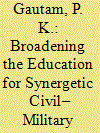

|
|
|
|
|
| Summary/Abstract |
Statecraft, diplomacy and warfare are not only a matter of brute force, but also a function of scholarship to understand the past, present and future of the art, science and literature of national and international security. At higher levels in their professional career, besides the armed forces, a number of civil servants too have to deal with the state’s use or threat of the use of legitimate force. This article suggests broadening the education for synergetic civil–military relations (CMR). This education needs to be imparted, and sustained, in the military as well as in the civil domain, including in particular the political leadership, bureaucracy, and the academic community. By doing this, a healthy CMR will generate superior strategies.
|
|
|
|
|
|
|
|
|
|
|
|
|
|
|
|
| 10 |
ID:
166051
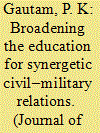

|
|
|
|
|
| Summary/Abstract |
Statecraft, diplomacy and warfare are not only a matter of brute force, but also a function of scholarship to understand the past, present and future of the art, science and literature of national and international security. At higher levels in their professional career, besides the armed forces, a number of civil servants too have to deal with the state’s use or threat of the use of legitimate force. This article suggests broadening the education for synergetic civil–military relations (CMR). This education needs to be imparted, and sustained, in the military as well as in the civil domain, including in particular the political leadership, bureaucracy, and the academic community. By doing this, a healthy CMR will generate superior strategies.
|
|
|
|
|
|
|
|
|
|
|
|
|
|
|
|
| 11 |
ID:
167822
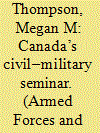

|
|
|
|
|
| Summary/Abstract |
The “civil–military gap” is a significant factor that can hinder the success of complex comprehensive approach missions. Perhaps nowhere is this gap more apparent than in the relationship between military and civilian nongovernmental organizations. Interagency education and training have been suggested as ways to diminish this divide. This research describes one Canadian approach to interagency education: the Civil–Military Seminar. Quantitative and qualitative results demonstrate the promise of both the assessment approach used and the positive outcomes that may help to narrow the civil–military gap.
|
|
|
|
|
|
|
|
|
|
|
|
|
|
|
|
| 12 |
ID:
175663


|
|
|
|
|
| Summary/Abstract |
After WWII, Japan established a unique system of civil–military relations and civilian control of its Self-Defense Forces (JSDF), characterised by bureaucratic rather than political control. For more than half a century, military influence on defence policymaking had been comparably low, depriving political leaders of a critical source of knowledge on national security. Yet, the latter half of the 2000s saw several institutional changes which resulted in the wide-reaching inclusion of military officials in national security policymaking. Why did a democratic Japan, shaped by WWII experiences, see the need for more military influence? The cause for this development ultimately lies within a changing security environment which lends credit to the broader argument that Japan has embraced a ‘realpolitik’ approach to national security.
|
|
|
|
|
|
|
|
|
|
|
|
|
|
|
|
| 13 |
ID:
167059


|
|
|
|
|
| Summary/Abstract |
The defence and foreign policy communities in the Global South should learn from the lessons of security governance that followed the 13-year United Nations Stabilization Mission in Haiti (MINUSTAH). To better inform the academic and policy debate, this article extrapolates ideas from the case study of Chile, one of the ‘big four’ Latin American peacekeeping providers in Haiti, along with Argentina, Brazil and Uruguay. The article examines Chile’s finished compromise with the MINUSTAH in order to shed light on conflict intervention strategies and its peace operations in Colombia and the Central African Republic. It argues that military policies for peace intervention purposes should undergo a critical reassessment in light of the state steering away from the past use of long-term brute force. Today’s changing security environment favours a set of different human security policies that have become more prevalent for peacekeeping policymaking. Engaging in scenarios of war and peace thus demands a more focused, experienced and tactical use of military and diplomatic resources than governments in the developing countries currently possess.
|
|
|
|
|
|
|
|
|
|
|
|
|
|
|
|
| 14 |
ID:
173133
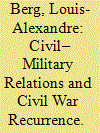

|
|
|
|
|
| Summary/Abstract |
Does restructuring security forces reduce the risk of civil war recurrence? Prior research has examined effects of military integration in alleviating commitment problems, but the evidence has been inconclusive. Other aspects of civil–military relations have received less attention. This article examines the effects of civil–military relations in the context of postwar struggles to consolidate authority. It outlines three pathways through which security forces contribute to renewed civil war: by excluding rival factions and facilitating insurgent mobilization, by exploiting control over resources to challenge the regime, or by escalating incipient insurgency through repression. Analysis of original, cross-national data on postwar civil–military relations shows that reducing the potential for exclusion and exploitation through diverse officer appointments and robust civilian oversight lowers the risk of civil war. These findings emphasize the distributive effects of restructuring security forces and highlight the value of examining political contests around state institutions to understand why civil wars restart.
|
|
|
|
|
|
|
|
|
|
|
|
|
|
|
|
| 15 |
ID:
186349
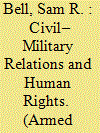

|
|
|
|
|
| Summary/Abstract |
Do civil–military relations influence human rights practices? Building on principal–agent theory, we argue that civilian–military relations, instead of having an effect on mean levels of repression, will be associated with the dispersion in human rights practices. States where there is less control of the military or more conflict between civilian and military leadership will see a wider range of human rights practices. We test our hypotheses quantitatively on a global sample of countries, using updated data on civil–military relations and find evidence that civil–military conflict and lack of control increase the variance in human right practices.
|
|
|
|
|
|
|
|
|
|
|
|
|
|
|
|
| 16 |
ID:
189920
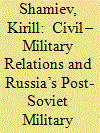

|
|
|
|
|
| Summary/Abstract |
This article studies the role of military culture in defense policymaking. It focuses on Russia’s post-Soviet civil–military relations and military reform attempts. After the fall of the Soviet Union, Russia’s armed forces were in a state of despair. Despite having relative institutional autonomy, the military neither made itself more effective before minister Serdyukov nor tried to overthrow the government. The paper uses the advocacy coalition framework’s belief system approach to analyze data from military memoirs, parliamentary speeches, and 15 interviews. The research shows that the military’s support for institutional autonomy, combined with its elites’ self-serving bias, critically contributed to what I term an “imperfect equilibrium” in Russian civil–military relations: the military could not reform itself and fought back against radical, though necessary, changes imposed by civilian leadership.
|
|
|
|
|
|
|
|
|
|
|
|
|
|
|
|
| 17 |
ID:
143283
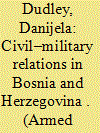

|
|
|
|
|
| Summary/Abstract |
Nearly two decades after the civil war, Bosnia and Herzegovina has yet to establish democratic control over its armed forces. While there is a widespread consensus that democratic consolidation is desirable, the process has been impeded by continuing challenges to state legitimacy. With three ethnic groups challenging state legitimacy, the reform efforts have been overshadowed by each group’s fears of others’ future intentions, leading thus to the maintenance of three armies for a decade after the war and nondemocratic defense relations to this day. The levels of challenges to state legitimacy, however, have varied. Due to the changing political environment, the early 2000s were characterized by a relative absence of nationalist rhetoric, allowing thus significant reforms of the defense sector. However, with reemergence of challenges to state legitimacy in 2006, the reform efforts came to a stalemate, leaving the newly established defense institutions without the capacity necessary for their functioning.
|
|
|
|
|
|
|
|
|
|
|
|
|
|
|
|
| 18 |
ID:
163212
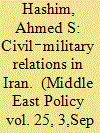

|
|
|
| 19 |
ID:
148966


|
|
|
|
|
| Summary/Abstract |
Civil–military relations, a subject of enduring concern in the US and a matter of intense debate during the presidential administration of Bill Clinton, have receded in the public mind to a matter of little immediate concern. As such, it is important to determine what tomorrow’s senior military leaders are thinking in this regard. Gregory Foster analyses the views expressed by a number of these future leaders enrolled in a course on civil–military relations at the National Defense University in Washington, DC, providing an insight into the minds of those who will lead tomorrow’s US military.
|
|
|
|
|
|
|
|
|
|
|
|
|
|
|
|
| 20 |
ID:
176225
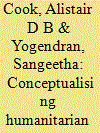

|
|
|
|
|
| Summary/Abstract |
The Asia-Pacific is a dynamic region that is exposed to multiple natural hazards. This article explores how recent developments have influenced the relationship between civilian and military actors in the Asia-Pacific to facilitate an improvement in humanitarian civil–military coordination to assist and protect disaster-affected communities. It investigates civilian and military engagement in disaster preparedness and response activities in the Asia-Pacific, and draws on the literature on civil–military relations and technical reports to further conceptualise these. This article analyses the 4Cs of disaster partnering in humanitarian civil–military partnerships in the Asia-Pacific—(1) Coexistence/Communication, (2) Cooperation, (3) Coordination, (4) Collaboration [Martin, E., I. Nolte, and E. Vitolo. 2016. “The Four Cs of Disaster Partnering: Communication, Cooperation, Coordination and Collaboration.” Disasters 40 (4): 621–643]. It argues that the Regional HADR Coordination Centre (RHCC), UN Cluster System, the Regional Consultative Group on Humanitarian Civil–Military Coordination for Asia and the Pacific (RCG), and Association of South East Asian Nations (ASEAN) centric mechanisms are illustrative of different orders of disaster partnering that are best understood as a combination of distinct and sequential activities. Through a clearer conceptualisation of humanitarian civil–military partnerships in the Asia-Pacific, this article aims to provide more informed expectations on what these partnerships may or may not deliver.
|
|
|
|
|
|
|
|
|
|
|
|
|
|
|
|
|
|
|
|
|